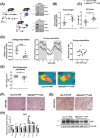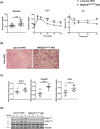Myeloid p38 activation maintains macrophage-liver crosstalk and BAT thermogenesis through IL-12-FGF21 axis
- PMID: 35592906
- PMCID: PMC9936978
- DOI: 10.1002/hep.32581
Myeloid p38 activation maintains macrophage-liver crosstalk and BAT thermogenesis through IL-12-FGF21 axis
Abstract
Obesity features excessive fat accumulation in several body tissues and induces a state of chronic low-grade inflammation that contributes to the development of diabetes, steatosis, and insulin resistance. Recent research has shown that this chronic inflammation is crucially dependent on p38 pathway activity in macrophages, suggesting p38 inhibition as a possible treatment for obesity comorbidities. Nevertheless, we report here that lack of p38 activation in myeloid cells worsens high-fat diet-induced obesity, diabetes, and steatosis. Deficient p38 activation increases macrophage IL-12 production, leading to inhibition of hepatic FGF21 and reduction of thermogenesis in the brown fat. The implication of FGF21 in the phenotype was confirmed by its specific deletion in hepatocytes. We also found that IL-12 correlates with liver damage in human biopsies, indicating the translational potential of our results. Our findings suggest that myeloid p38 has a dual role in inflammation and that drugs targeting IL-12 might improve the homeostatic regulation of energy balance in response to metabolic stress.
Copyright © 2023 The Author(s). Published by Wolters Kluwer Health, Inc. on behalf of American Association for the Study of Liver Diseases.
Conflict of interest statement
Nothing to report.
Figures





References
Publication types
MeSH terms
Substances
LinkOut - more resources
Full Text Sources
Molecular Biology Databases

